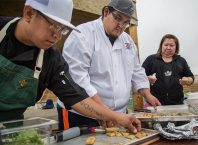Recent Ojibwe high school graduates carried shovels full of dirt from huge piles of excavated soil and poured them into screened boxes, then sifted the dirt onto the ground, revealing tiny objects left on top the screen.
The young workers became excited as they gathered together and examined the little pieces of rusted metal, glass, rock, or bone fragment. They brought the peices over to their foreman, Bob Sander, if they looked to be of particular interest. Sander checked them over with great detail and placed them in a plastic baggie.
One object was an etched deer knuckle bone that had been used in earlier centuries as a game of skill. The Ojibwe once referred to this game as Pepengunegun, a cup and needle game that required players to skillfully thread a bone needle through the thimble-like knuckle bone.
“Our history is important. We have to uncover more of this before our
history, or even this game, becomes lost,” stated Sander, to emphasize
the value of the excavation project.
The workers were hired by the Lac Courte Oreilles tribe as a part of a
project to investigate about fifty tons of excavated soil that had been
dug up by heavy machinery for a water line project in the main village
of Reserve.
“It was May 1st, I believe,” stated Brian Bisonette, tribal council
leader, “when Jerry notified me about the uncovering of bones.”
Jerry Smith serves as the tribal historic preservation officer for Lac
Courte Oreilles. On May 1st, he watched the machinery dig the trench
for the new water line in Reserve. After about thirty feet of work,
the John Deere excavator scooped up fragments of large bones and dumped
them on the ground. Smith spotted them and immediately reported the
findings to Bisonette. The water line project was stopped.
Tribal police were called in to investigate the bones to determine
whether they were human, recent, and if foul play was involved. Once
the Tribal police gave clearance, tribal officials conducted a Native
American Graves Protection and Repatriation Act (NAGPRA) search of the
material unearthed.
“There’s shallow graves all over the reservation,” said Bisonette, as
he explained the historic conditions that led to emergency burials of
tribal people through the years. He described the early Twentieth
Century flu epidemic that killed dozens of Ojibwe and left most
villages without men to dig deep graves.
The Tribal Council stopped the water line project and hired youth
workers to dig and sift through the excavated soil to ensure that it
will not disturb human remains at this site. NAGPRA is a federal law,
passed in 1990, that requires companies doing excavation work to follow
a procedure for the treatment of unearthed human remains or objects of
cultural value.
“We don’t have a tribal ordinance yet for a protocol with excavated
remains,” said Bisonette, “even though we’ve been working on one for
some years and I believe it will soon be adopted.”
Bisonette said that tribal policy over this matter follows “custom
law,” a procedure that requires spiritual leaders to rebury the remains
or funeral artifacts uncovered by accident.
Rebecca Nickence ( a local teen) volunteered as an archeology assistant
on the project. “I was working at the Reserve Elderly Center as a
volunteer, so I volunteered to work out here,” she said, as she pointed
her hand toward the sifting area. “I’m learning a lot about our tribal
history from Jerry and Bob,” she said. Nickence says the dig site has
revealed more about Lac Courte Oreilles history.
Another teen, Thomas Smith, Jr. (a relative of Jerry Smith) follows the
history lessons that are being provided on site by the elder tribal
historic preservation officer. “I like working outside and learning new
things about our history,” said Smith, Jr., “and I’m very anxious with
archeology.”
Both teens said they would like to go to school to study archeology.
They explain the connection between the layers of earth that were
uncovered, to the eras of tribal history that have been taught by Jerry
Smith.
“I hold my breath every time I see a water line project going on at
Reserve,” said Bisonette, “it is our responsibility to preserve and
protect our history and our forefathers.”
Mark St. Germaine, Lac Courte Oreilles Ojibwe, will be a sophomore in
high school at Eau Claire Memorial. He can be contacted at
stgermrd@aol.com.
(cutline for story photo: Teen archeology assistants have acquired
career interests in archeology and tribal history from the discoveries
they’ve made. L-R: Rebecca Nickence, Thomas Smith, Jr., and Cynthia
Potack. (Photo by Mark St. Germaine.))






